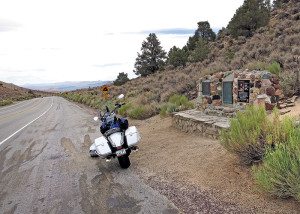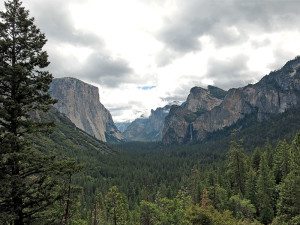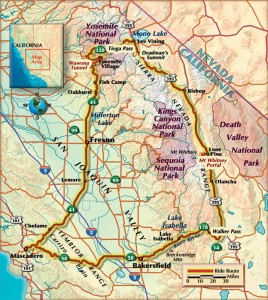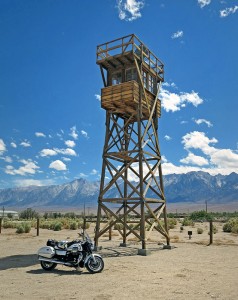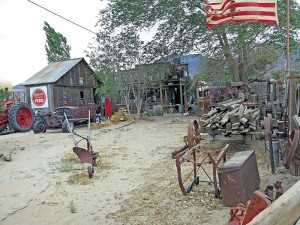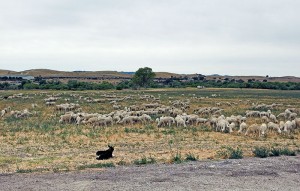Back roads make me happy. Two lanes, little traffic, preferably with lots of curves and undulations, rather like the better parts of California Routes 58, 120 and 178. Lots of gear changes, lots of lean, maybe a little braking on occasion when the yellow and black warning sign says 30 mph and the speedo reads 60. This California 1400 Touring certainly enhanced that happiness. It has a smooth engine, is surefooted and, despite its 700 pounds and 66-inch wheelbase, handles quite nicely, with three Brembo discs assisted by ABS doing the stopping bit.
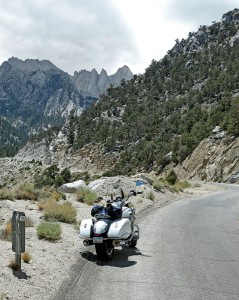
Moto Guzzi is getting back into the big-cruiser market in a big way with the new California. You have already read the road test in the September 2013 issue; this is another assessment from a road trip. Cruiser-type motorcycles are big business, and apparently the most desirable have V-twin engines. But nobody said such a motor has to be placed fore and aft, like Harley, Honda, etc. It could go sideways. Sideways has several advantages, the primary one being better cooling—the two cylinders sit out in the air, rather than one behind the other.
Touring versions of all these V-twin cruisers have become popular, from Harley’s Switchback to Yamaha’s Silverado, coming with bags and windshield out the door. Now an Italian is in the running, aesthetically pleasing, with voluptuous lines and sensuous 24-spoke mag wheels…and a rather famous name.
Moto Guzzi has been peddling its California model since 1971 when it was powered by a 757cc engine. That California had mildly Harley-ish looks, the factory calling it “American-style” trim, and a whole slew of accessories, like saddlebags and windshields. If anybody has a ’72 in the garage, check out that chrome-plated grab rail at the back of the seat…looks just like the one on this 2013 I am riding. The Guzzi 90-degree V-twin has grown over the years, from the 703cc of 1967 to the 1,351cc of today, now with a whopping great 104mm bore, 81.2mm stroke.
Throw a few things in the bags, give the wife a kiss and I’m off to see how the Goose really works. We live in a river valley, with low hills on either side, and the temp gauge up above the tach reads a pleasant 70 degrees. Headed east, I go up Chicago Grade to the Atascadero Summit at a modest 1,400 feet, then angle onto State Route 58, crossing the Carrizo Plain to climb over the Temblor Range, summiting at some 3,200 feet. From the top, I am looking across a mildly hazy 70 miles of the San Joaquin Valley and can see the west side of the Sierra Nevada range; that high one is probably 7,600-foot Breckenridge Mountain. These are the nearest serious mountains to my house, and they include the highest peak in the continental U.S., Mount Whitney, at over 14,000 feet.
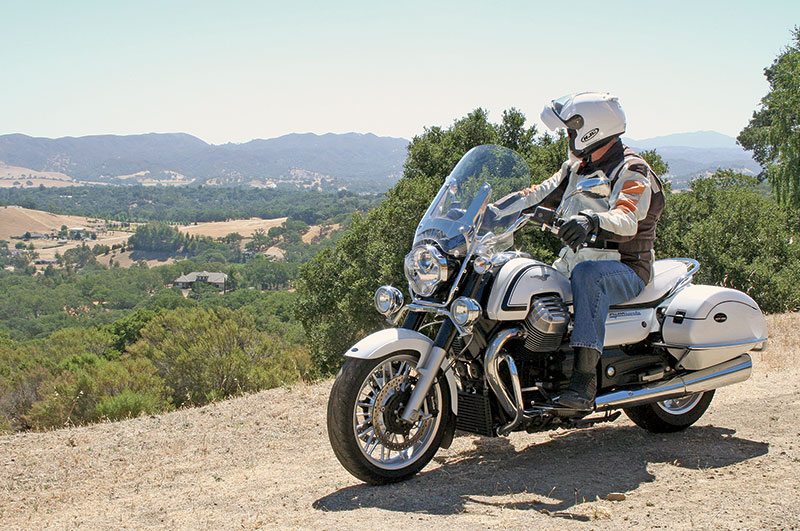
I’m going to head over Walker Pass. At 5,280 feet, it’s the southernmost and lowest pass in the Sierras. Then I’ll ride north 200 miles to go back across the mountains on the highest pass, Tioga, at 9,945 feet. Give the Goose a good workout.
It’s a delightfully twisty ride down the east side of the Temblors. With a 66-inch wheelbase and an effective fork angle of 38 degrees, the Cal 14 likes to take the tight curves at a moderate speed; I’m amenable. Although being in a cruising mode, I still enjoy a good lean, and am pleasantly surprised when I hear nothing scraping; good cornering clearance on this bike. A pair of shocks support my butt, with the preload set in the middle position, but no way can they be adjusted without unbolting the saddlebags. However, I do find the setting quite adequate. Good thing, since I don’t want to find out if my CruzTool kit has all the necessary bits…the Goose does not come with its own wrenches.
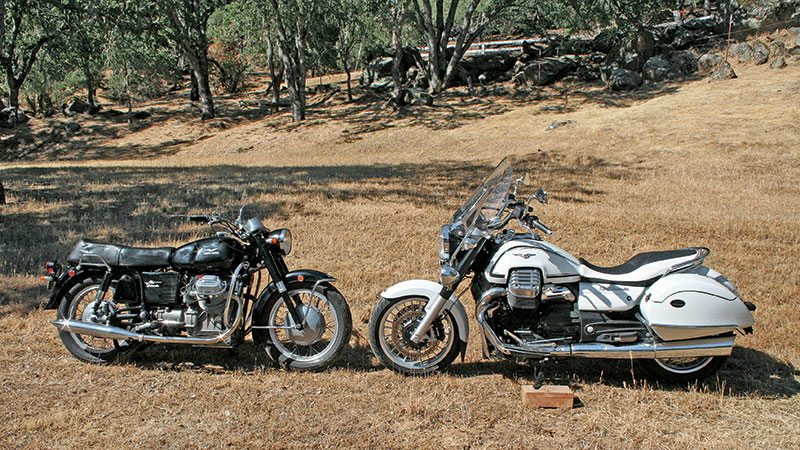
Speeding across the valley, which gets as low as 300 feet above sea level, I end up slowing down as I enter the heavy stop-and-go traffic leading into Bakersfield. I can’t deny the fact that the Goose’s cylinders put out some heat; but it’s not bad, and chrome covers running from the cylinder heads back alongside the fuel injectors keep my knees from touching anything really hot. Not all of our editors were as forgiving, as one complained about the heat, making references to Rocky Mountain oysters. I also note the two-stage aspect peculiar to fuel-injected bikes when rolling-off the throttle at low speeds and stops, with a slow-down, then a slight surge and another slow-down. I got used to it, but I think it could be made smoother.
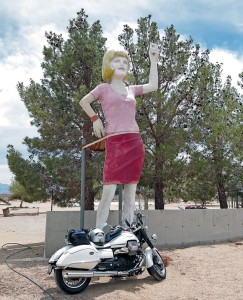
In the middle of Bakersfield, Route 58 cuts south, while State Route 178 goes straight east, and before long I’m cruising into the Kern River Canyon. Cruising may not be the right word, as that stretch of pavement is another very, very twisty bit as we enter the canyon and head upstream. Monday morning, nobody but me—and two delivery trucks that pull into turnouts as soon as they see me in the rearview mirror. Speaking of which, the Cal 14 has good mirrors, and with Guzzi’s “elastic engine” mounting, vibration is virtually non-existent at speed. Though when I’m stopped at a light, I am reminded of Guzzis of old with the engine shaking around.
The controls are good, with thick grips at each end of the bars, and adjustable levers. There are a whole bunch of buttons and levers to play with, offering cruise control, traction control and three engine mapping choices—Pioggia (rain), Turismo and Veloce. I find Turismo to be my choice, as I don’t need the little extra that Veloce provides, and it hasn’t rained. Yet. This bike also has some powerful lights, with a pair of spotlights and a polygonal headlight bracketed by LEDs that will freeze a deer in its tracks. I’m not much of a nighttime rider, but I do appreciate maximum visibility when it has to be done. Not everything’s perfect, of course, and the tinny pair of horns belong on a child’s tricycle.
We climb up to Lake Isabella at 2,500 feet, more than a bit depleted after a very dry winter, and head along the valley toward Walker Pass. Old Joe Walker was a mountain man, one of those long-ago types who could live off the land as long as he had a little gunpowder to shoot game. He first crossed this pass back in 1833, and explored the Sierras for the next 35 years; look around the 400-mile long range and you’ll find at least a dozen places with Walker’s name.
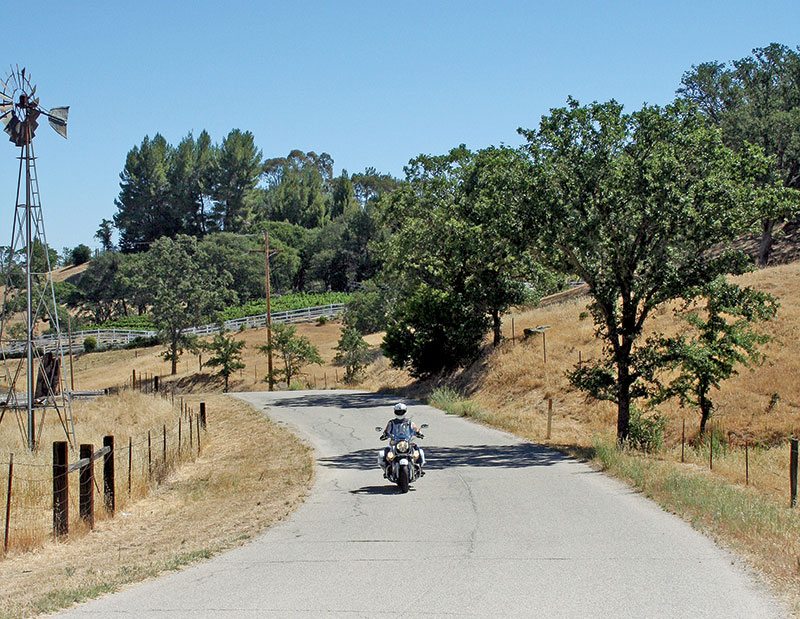
Now we roll downhill to a big road, State Route 14 (apt!), which merges into U.S. 395 a few miles to the north. U.S. 395 is a major highway, running right up the eastern side of the Sierras, catering to the tourist trade. In the winter, skiers head north from Los Angeles to the big resorts, or to Death Valley, just off to the east. The rest of the year there’s still more tourists, taking advantage of all that the mountains have to offer. Me? I set the cruise control at 70 and admire the views of the mountains, enjoying the 80-degree day.
At Olancha, a sign points off to the right and tells me that Furnace Creek, the center of Death Valley, is a mere 100 miles away. What it does not say is that in this first week of summer the temperature will be approaching 120 degrees Fahrenheit…it actually reaches 128 F a few days later. I push on to Lone Pine, and after getting a sandwich at a deli for a very late lunch, decide to take the road to Whitney Portal and enjoy my meal there, at 8,300 feet.
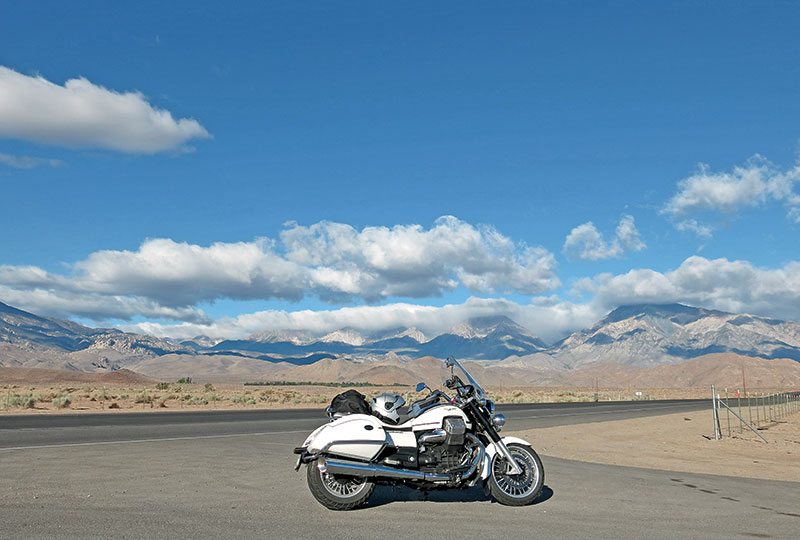
It’s an easy road with stunning views climbing the 12 miles and 4,600 feet to the Portal, where those athletic types who want to get to the top of Mount Whitney park their cars to start the 22-mile round-trip trek. I watch some of these stalwart, smiling hikers start up the trail, and also note the exhausted, hollow-eyed returnees coming back down. I’m happy on my motorcycle.
With lunch done, it’s back down to Lone Pine and a return to 395. It’s only 60 miles to Bishop, which is a major tourist spot along the highway, offering more than 20 motels to sleep in and 30 restaurants to feed you. I find a room in an old-fashioned motel, the kind where the windows open and I can park right in front, and check the weather channel. There’s a rain front moving south, but it’s supposed to stop somewhere right around Yosemite National Park. We’ll see. Dinner? Right next to the motel is a Japanese restaurant, while a couple of blocks farther along is Upper Crust Pizza. I opt for the Italian food and California wine.
Morning shows clouds up north, more or less hugging the mountains. I’ve got raingear if necessary, and I’ve put a couple of layers on under my riding jacket. Bishop lies at about 4,100 feet, and 50 miles later I feel chilly as I go over Deadman’s Summit at 8,000 feet. Going to get chillier.
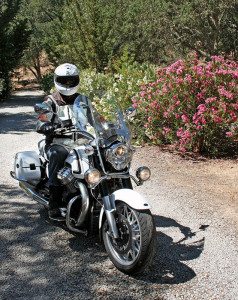
occasional unpaved roads quite easy—but no soft sand, please.
Pulling into Lee Vining, near the entrance to Yosemite National Park on the east side of Tioga Pass, I gas up. A bit of a sprinkle is wetting the ground; Lee Vining is at 6,700 feet, but since I’m going up close to 10,000, I add another layer of warmth and then the rain pants, jacket, boots and gloves and head up State Route 120—but not before putting the engine status on Pioggia. It does make a big difference, slowing the power down so to speak, so much so I don’t like it and go back to Turismo. Adjusting engine output electronically is not high on my priorities, as I think I can do a good job controlling the throttle with my right wrist. And while traction control may have a definite advantage when riding sportbikes really fast, I’m certainly not going to be over-revving the engine on my way up to Tioga.
Up and up we go, with clouds occasionally covering the road, a steady light rain and the temperature gauge on the dash steadily dropping. At the entrance to the park at 9,945 feet, it’s windy, wet and 45 degrees. Now for the long 50-mile drop down Tioga Pass Road, past rain-washed rock, cloud-covered lakes and mossy-green sequoia trees, occasionally foggy, until I get to the stop sign at the bottom: Yosemite Valley, left, State Route 120, right. I go left and drop down even more into the valley. Somebody asked Joe Walker what the happiest day in his life was and he said it was camping in Yosemite Valley. Though he might not have liked it today when it is jam-packed with tourists.
From the valley, I head south through the 4,200-foot Wawona Tunnel on Wawona Road, which will morph into State Route 41 as soon as I exit the park at Fish Camp. Home is less than 200 miles away, a good thing because with 4,000 miles on the bike’s odometer the rear tire is just about done.
It was a short trip, but a thoroughly enjoyable one—even with the weather. The Moto Guzzi California 1400 Touring does make a good touring motorcycle. Its seating position is relatively upright, with the patrol windshield keeping the wind away. The seat is comfortable, the gas tank holds 5.4 gallons, and the big twin averaged a reasonable 40 mpg over the 1,200 miles I put on the bike. I could easily do a coast-to-coast on this veloce turismo motorcycle, even with a little pioggia.
(This article Mountain Goose: Moto Guzzi’s California 1400 Touring in California’s Sierra Nevada Mountains was published in the October 2013 issue of Rider magazine.)

